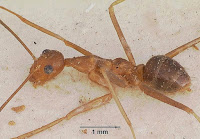Ants of the genus Romblonella
are found across much of Indonesia as well as parts of the Philippines,
Australia and Fiji. The genus was originally erected in 1935 to describe a new
Ant species from Romblon Island in the Philippines, though it was later
discovered that this species had previously been described from Sulawesi; since
the Sulawesi species had been incorrectly placed in a pre-existing genus with
Ants to which it was only distantly related the genus name has remained in use.
This species, Romblonella opaca, is
now known from four islands of the Philippines plus several islands in
Indonesia, though all other described species in the genus appear to have very
limited and localized distributions.
In a paper published in the journal Halteres on 11 May 2015, David General of the Los Baños Museum of Natural History at the University of the Philippines and Perry Buenavente of the National Museum of the Philippines
described a new species of Romblonella
from Palawan Island, the second species in the genus known from the
Philippines, the first species from Palawan and the only species known only
from the Philippines at this time.
The new species is named Romblonella coryae,
in honour of the former Philippine president Corazon Aquino. The species is
described from nine worker Ants collected in and around a camp in Cleopatra’s
Needle Forest on Palawan. These are between 4.60 mm and 4.88 mm in length and
dark brown in colour with dark orange markings on their backs and yellow on
their mandibles, antennae and first and middle pairs of legs.
Romblonella coryae, worker Ant in lateral view. General & Buenavente (2015).
Very little is known about the biology of Romblonella Ants; most species are known only from a handful of
specimens, typically collected at the same time, and the genus is known from a
few isolated spots across a very wide area. General and Buenavente suggest that
the locations from which the known specimens of Romblonella coryae were collected may shed some light on this. The
camp around which they were found was located in primary rainforest (i.e.
rainforest comprising tall trees with a dense canopy but limited groundcover)
in a lowland area about 200 m above sea level. Four of the specimens were
collected from the tops of tarpaulins in the camp, two from leaf litter in the
camp, and three from nearby trails. General and Buenavente suggest that this
distribution may imply the species nests in the canopy of the forest, and the
collected individuals may have been blown out of the trees and have fallen to
the ground. They suggest that investigating the canopy may reveal more about
this species and other members of the genus.
Known localities of Romblonella Ants in the
Philippines. David General in General & Buenavente (2015).
See also…
Ants are often highly adaptable animals, and many species have
proven to be highly invasive pests, able to reach new homes by hitching a ride
on cargo moved by Humans, and often proceeding to modify...
Ants and Termites are eusocial Insects that have dominated many
tropical ecosystems since at least...
Follow Sciency Thoughts on Facebook.





